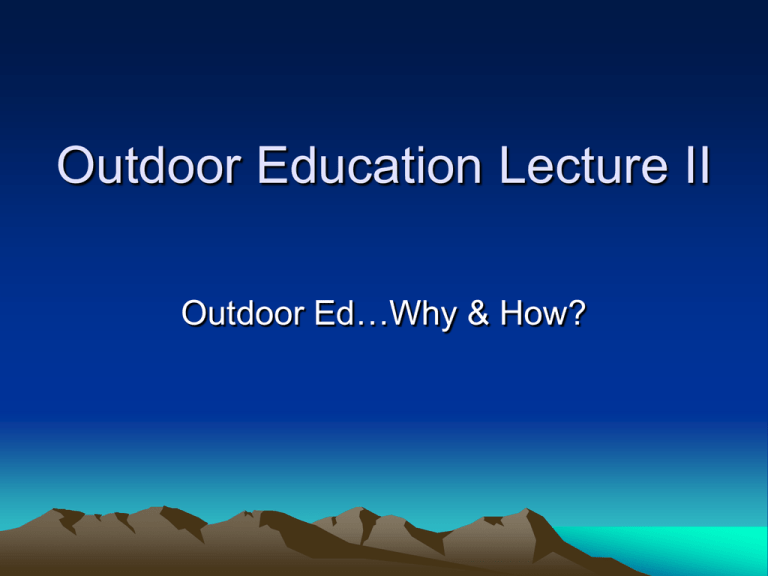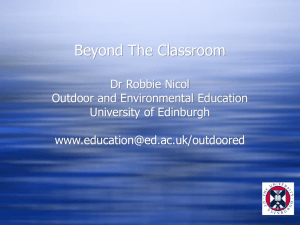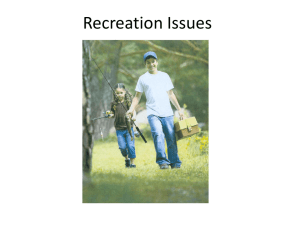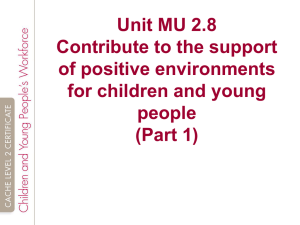File
advertisement

Outdoor Education Lecture II Outdoor Ed…Why & How? Why teach Outdoor Education The need for… Effective learning. Extending the learning process into instructional settings beyond the classroom provides the opportunity for bringing greater understanding, deeper insight, and clearer meaning to those areas of knowledge which all too often, are merely read and discussed and are seldom experienced. Basic concepts. Outdoor education provides teachers with a vehicle fro bringing real meaning to abstract concepts. Realism in education. Lessons of life are found at every hand in the outdoor classroom. Students don’t need to rely on words alone, they can use all of the senses to learn. Awareness. Modern young people are missing a basic aspect of their own existence – acquaintance with the earth upon which we depend for our livelihood and survival. Environmental appreciation. Because so much of our lives center on the acquisition and use of material objects, there is a need to counterbalance this devotion to things with inner renewal that can be derived from enjoying the simpler things in life. Environmental literacy. Human survival may well depend upon our ability to control the pollutants with which we despoil the land. School as institutions are the primary places of influence that will affect the masses. Recreation experience. Outdoor activity can be a major contributing force toward improved physical fitness and better health. How – Theories that can be applied • Experiential Education • Maslow’s Hierarchy • Optimal Arousal • Constructivism APPLYING EXPERIENCING GENERALIZING REFLECTING Experiential Education Experiential learning focuses on the growth and success of both individuals and groups. It incorporates a Brief-ActivityDebrief model involving discussion and framing of activities beforehand, and debriefing (reflection/discussion) following the experience. Metaphor is used often in this sequence and facilitates cooperative reflection leading to transference and generalization in everyday life, as well as in both individual and group circumstances. Communication, fun and laughter enhance the process. APPLYING EXPERIENCING GENERALIZING REFLECTING Maslow’s Hierarchy Shows exactly what a person needs. A strong foundation must be built in order for the other levels to build upon one another. Each foundation level must be strong to get to the next level, and so on. If one level is weak, then the needs above that level will be very difficult to develop, because all of the needs interrelate. Optimal Arousal Arousal is a major aspect of many learning theories and is closely related to other concepts such as anxiety, attention, agitation, stress, and motivation. The arousal level can be thought of as how much capacity you have available to work with. Yerkes-Dodson law predicts an inverted U-shaped function between arousal and performance. A certain amount of arousal can be a motivator toward change (with change in this discussion being learning). But too much or too little will certainly work against the learner. You want some mid-level of arousal to provide the motivation to change (learn). Too little arousal has an inert affect on the learner, while too much has a hyper affect. Also, there are optimal levels of arousal for each task to be learned. The optimal level of arousal is: lower for more difficult or intellectually (cognitive) tasks, higher for tasks requiring endurance and persistence Constructivism Learning is a process of constructing meaningful representations, of making sense of one's experiential world. In this process, students' errors are seen in a positive light and as a means of gaining insight into how they are organizing their experiential world. The notion of doing something 'right' or 'correctly' is to do something that fits with "an order one has established oneself" (von Glasersfeld, 1987, p. 15). This perspective is consistent with the constructivist tendency to privilege multiple truths, representations, perspectives and realities. The concept of multiplicity has important implications for teaching and learning: Outdoor Education History Outline • • • • • 1. Tribal Life 2. Civilization 3. Post-industrialization 4. Life-cycle of OE Programs 5. Trends 1. TRIBAL LIFE Once upon a time…. (for a very long time) all education was outdoors Education was a way of life…. It was hands-on… And directly related to immediate & future demands of living Most OE programs emulate some aspects of tribal life, e.g., living in the outdoors Some OE programs make special effort to involve aspects of traditional tribal life: e.g., animal tracking skills, etc…. 2. CIVILIZATION Another name for the Holocene period is the Anthropogene period, i.e., the "Age of Man" because during this period all of humanity's recorded history and the rise and fall of all its civilizations have occurred. OE is a phenomenon of post-modern Western society; it does not occur (as we currently understand and define it) in Eastern society or in pre-modern Western society because it requires a distancing of civilization from nature. As human civilizations evolved, knowledge was recorded and stored, and so it became necessary to efficiently ‘transfer’ cultural knowledge to maintain social order. Gutenberg invented the printing press 600 years ago. Until then all books were handwritten and rare/precious, housed by the churches. With the invention of the printing press, the oral education tradition began to give way to the written education tradition. Dr. Kurt Hahn, German educator who inspired many innovative educational experiments including the beginning of the Outward Bound movement in 1941. 6 Declines of Modern Youth (Dr. Kurt Hahn, 1930s) Fitness due to modern methods of locomotion Initiative and enterprise due to the widespread disease of ‘spectatoritis’ Memory and imagination due to the confused restlessness of modern life • Skill and care due to the weakened tradition of craftsmanship • Self discipline due to the ever-present availability of stimulants and tranquilizers • Compassion due to the unseemly haste with which modern life is conducted or as William Temple called “spiritual death” 4 Antidotes of Modern Ills (Dr. Kurt Hahn, 1930s) • • • • • Fitness Training Expeditions Projects Rescue Service Outward Bound was NOT the first OE Program Three examples of pre-OB OE developments • 6th century BC, Ancient Greece – mountain climbing, hunting and horseback riding to emotionally strengthen youth for their roles as citizens and solidiers Pre 1800 to early 20th Century Friends Hospital opens in Philadelphia. A major component of treatment is based on idea that natural environment is healing for the "mentally ill" cited in Davis-Berman, & Berman, (1994) 1901 "Tent therapy" - on the hospital grounds Manhattan State Hospital East to isolate TB patients from other patients. cited in Davis-Berman, & Berman, (1994) 1929 Camp Ahmek, beginning of a "therapeutic approach" to camping cited in Davis-Berman, & Berman, (1994) 1946 Salesmanship Club of Dallas (Campbell Loughmiller) – beginning of therapeutic camping movement http://www.salesmanship.com/pages/history.html http://fdsa.gcsu.edu:6060/lgillis/AT/2IATC/advthe.htm • German “Wandervogels” “At the beginning of the twentieth century groups of students formed themselves into Wandervogel, the Wandering Birds . At first they were very earnest young people, fully of nostalgia for the Germany of a purer age in the remote past. Alcohol and tobacco were renounced by many members. Simplicity, idealism, self-control were keynotes of the early phase of the movement… Every weekend the countryside was invaded by young people. Great importance was attached to singing round the campfires to create a spirit of brotherly communion. Relics, monuments and places associated with Germany’s undefiled past were objects of pilgrimage. The present day Germany by comparison was insidious and corrupt, controlled by selfseeking adults. The Wandervogel was a youth movement controlled by youth, unlike one its counterparts in English speaking countries, namely, the Boy Scouts, which is so clearly tied to adult patronage – one the reasons for its recent relative decline. German youth, on the other hand, went a-wandering to escape both teachers and parents. 3. POSTINDUSTRIALIZATION 21st Century Western Society There is clear evidence of systemic and chronic human maladaption, e.g., worsening: • mental health For example, rates of depression and anxiety, the two disorders which account for approximately 50% of all mental health disorders (Seligman, *), have substantially increased in their prevalence rates over the last 50 to 100 years. For depression prevalence trends see Fombonne, 1998; Joyce, Oakley-Browne, Wells, Bushnell, & Hornblow, 1990; Klerman, 1985; Klerman & Weissman, 1989; Lavori, et al., 1987. For anxiety prevalence trends see Twenge, 2000). It also appears that the average age of onset for depression is occurring earlier (Joyce, et al., 1990; Klerman, 1985; Klerman & Weissman, 1989; Lavori, et al., 1987). It also interesting to note that suicide accounts for approximately half of all violent deaths, with suicide rates highest in high-income societies (World Health Organization, 2001). • social/cultural health Examples of significant social problems are increasing rates of unemployment, violence and crime. The global unemployment rate is now as high as ever at approximately 30% (International Labor Organization, 1996) and is expected to remain a major long-term problem with adverse social effects (World Health Organization, 1994) and although the most recent trends in the unemployment rates are improving, there remain deep problems (International Labor Organization, 2001). With regard to violence and crime, there have been clear increasing trends in Australia over the past 20 years (Weatherburn, 2002). In the United States, there are some divergent views about violence and crime rates. According to Blumstein (2000), there have not been any consistent trends up or down over the past 40 years. However, the American Psychological Association (n. d.) claims that people mistakenly believe that violence in the United States is on the downswing because crime overall has decreased since the early 1980s. Much of this decrease, it seems, is attributable to the aging of the baby boom generation and consequent reduction in the numbers of teenagers, the demographic group that contributes disproportionately to crime rates. Thus, according to the American Psychological Association (n. d.), violent crime continues to be on the up in the United States, especially among juveniles, and this trend seems likely to continue (American Psychological Association, n. d.). Perhaps what is more notable but also often overlooked, is that the United States, an “exemplar” developed country, has homicide rates approximately 20 times greater than in most other industrialized countries (Shannon, n. d.). • environmental health For example global warming attributable to human activity, rate of usage of non-renewable resources which is 20% in excess of what is sustainable (*ref WWF report http://www.worldrevolution.org/), ongoing destruction of natural habits resulting in increasing numbers of endangered and extinct plant and animal species • physical health now recommended that people need minimum 1 hour a day of physical exercise to prevent obesity Responding to 21st Century Needs Education, social services, government, etc. all need to respond to post-industrial needs We must invest in promising, creative avenues, e.g., outdoor & experiential education 4. LIFE CYCLE OF OE PROGRAMS International Life Cycle (Priest, 1999) Outdoor Education Internationally 5. TRENDS 1. Increasing disconnection between what academics interested in OE want to spend their time doing and what people and organizations in the field want from academics. Basically, academics want to study process, people in the field want evaluation outcomes. 2. The new generation of content is emerging in web-form. Basically, websites such as Active Reviewing, OutdoorEd.com, and the Outdoor Education Research & Evaluation Center are collectively serving hundreds of hits for research info each day, seemingly reducing traffic on listservs. 3. No significant changes in the quality or quantity of research and knowledge generation in traditional publication forms. Basically, it appears that there are no current major initiatives in building substantial new research programs or generation of new theory, etc. that are likely to bear significant fruition in the coming year. If I could pick one exception, it would be Keith Russell's work on AT research at the Wilderness Research Center, Uni of Idaho. Don't get me wrong - there is other good work around - but there is little work that is appearing as part of a long-term knowledge-building strategy. One study proves nothing - a series of cumulative studies can. 4. Increase in 'research at the fringes'. OE methodology remains compelling and needed; it will continue to attract increasing attention from alternative-thinking psychologists, social workers, educators, etc. and this will continue to foster a bubbling of 'research at the fringes'. While tantalizing and interesting, such research is never going to go deep within OE to build a new platform of knowledge. 5. Domination of US-based research will begin to wane. In the beginning decades of OE since World War II, the UK generated the little research and theory-building that was conducted, then the US dominated in terms of programming, theory-building and research from the 1960s-1990s. This domination may have peaked. Little new seems to be emerging from the US, and there is too much focus on safety, liability, risk management, etc. issues. On the other hand there are positive signs of knowledge-building growth from the UK and Europe. In the longer-term, future decades could see the significant emergence of OE knowledge-building from Asia. The situation in Australia / New Zealand seems to be, like the US, somewhat stable or in possible decline. 6. Adventure Therapy - the one to watch. Adventure therapy may emerge during the coming decade as a significant hothouse for the development of OE-related theory. 7. Graduate Training will be sought. As organizations mature and become increasingly sophisticated, they will have an increasing need to have managerial and director-level staff who have received post-graduate training. At the same time, universities are increasingly under the pump to bring in dollars, but most of this comes from undergraduate education. . 8. The big and small OE organizations are endangered. The big organizations such as Scouts and Guides, Outward Bound, Project Adventure, and NOLS all faced a very tough decade in the 1990s. The big movers now are the medium-sized, specialist organizations. Small operators are going to continue to suffer greatly with all the increasing administrative challenges of running programs. 9. The possible connections between outdoor education and other fields will become more apparent. In the global, multiple age, a key strength to survival and evolution is investing in connections. Thus, connections between OE and other fields will emerge as increasingly important in the coming decade. 10. The role and purpose of nature in outdoor education will become more apparent. As society becomes more disconnected from natural environments, the primary importance of human experience in nature becomes more highly valued and studied. Whilst the USdominance of outdoor education during the 1960's-1990's lead to adventure programming approaches which place little emphasis on human relationship with nature, it is predicted that the role of nature will emerge during the next decade as being more critical in OE theory and research. • Proliferation of OE programming • Increasing diversity in: – Purposes – Cultures – Locations – Methods – Participants – Staff – Death or Evolution of OB?





